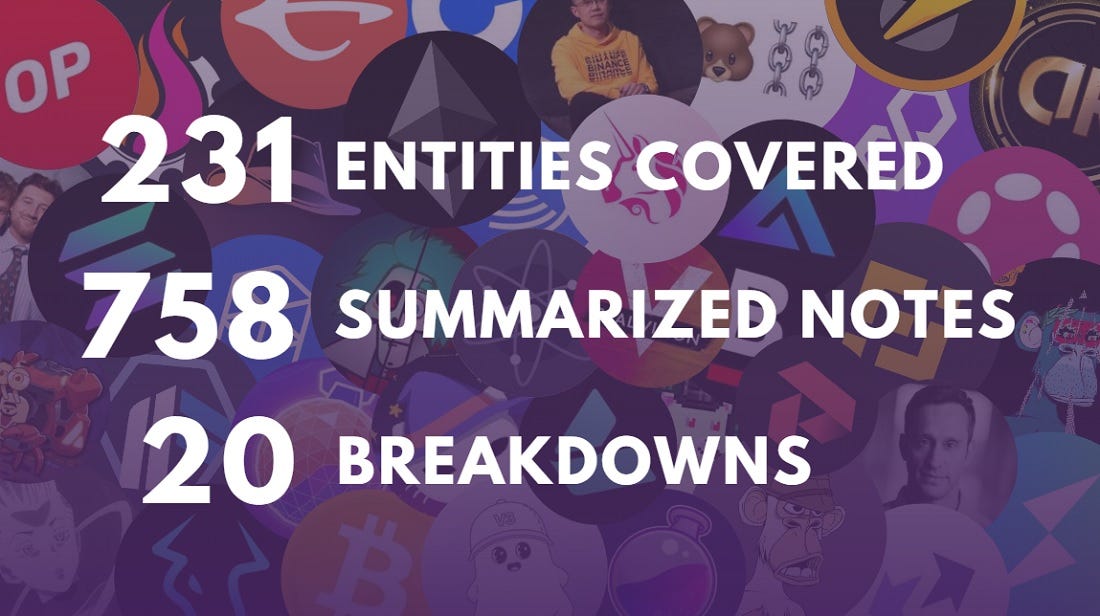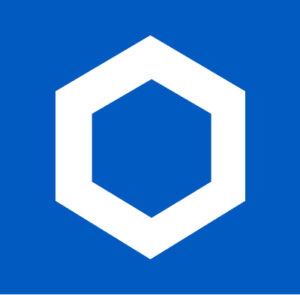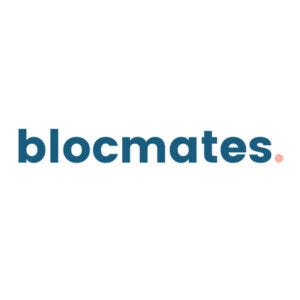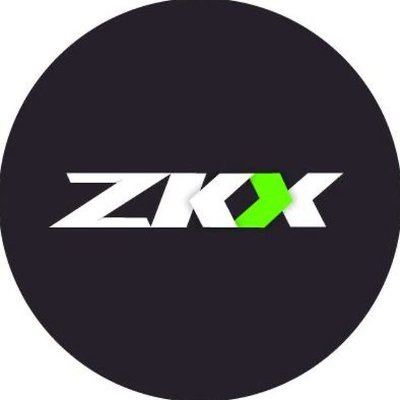When is ZKX Launching it's Starknet Testnet & what are the latest updates from the team?
Update from Osmosis Labs | Bitcoin native banking system | Silvergate situation | Web3 marketing tactics | Interop Summit with Stani Kulechov
Attention degens, this is today’s Daily Bolt briefing.
Today we bring to your attention several brief research reports on Osmosis and Chainlink, both significant projects that we have published breakdowns on.
And, for your note of the day: ZKX, a perp futures DEX on Starknet, shares some of their marketing updates and how they’ve integrated Crew3, the platform that more and more projects are using to interact with their audience and users.
Over and out.
Key Discussions Happening Today
1/ Osmosis Twitter space - Update from the Labs - Mar. 8, 23
Preview: Syed Rahman and Crypto Tax Calculator discuss Web3 onboarding, product team, taxes and more. Click here to listen to the full episode.
Length: 51 mins | OUR NOTE: 2 mins
Here are some key takeaways:
They (the Osmosis team) are trying to be hyper vigilant on looking at the data and feedback from all of their users.
One of the biggest things they need to improve is onboarding.
Onboarding right now in Web3 takes a lot of time and effort to watch tutorials and do other things to get started.
2/ What Bitcoin Did Ep. 625 - The Future of Bitcoin Banking
Preview: Eric Yakes, author of ‘The 7th Property’ joins Peter McCormack to discuss how a Bitcoin native banking system could evolve. Click here to listen to the full episode.
Length: 94 mins | OUR NOTE: 7 mins
Here are some key takeaways:
Eric has been delving deeper into the practical side of the banking system.
There are new protocols being built, such as those leveraging Bitcoin, that will be pivotal in building an alternative financial system.
Eric thinks that Bitcoin needs to be an alternative monetary system because it is necessary to solve many of the problems in the current financial system.
3/ Interop Summit - with Stani Kulechov
Preview: Maria Shen, Austin Federa, Marek Olszewski and Stani Kulechov talk about what Web3 achieves, why they work in this technology and more. Click here to listen to the full episode.
Length: 32 mins | OUR NOTE: 3 mins
Here are some key takeaways:
Celo is an EVM-compatible chain with a focus on payments and increasingly on ReFi.While FTX and Alameda aren't directly going after the SEC, their case is indirectly doing the same thing, the same argument that Grayscale is presenting as well.
Uniswap launched on Celo last summer, Curve launched on Celo last fall.
They have a lot of users in South America and Africa that use stablecoins on top of Celo to pay for things, cashing in and out easily and using something called via connect.
📚 Research Using Revelo | 🐦Follow Twitter | 🎥 Subscribe to YouTube
4/ Chainlink - Web3 Marketing Masterminds with Jenn Duong of ParaSpace
Preview: Cristina Moscosa is joined by Jenn Duong to discuss core principles, strategies, Web3 marketing tactics and more. Click here to listen to the full episode.
Length: 46 mins | OUR NOTE: 3 mins
Here are some key takeaways:
Paraspace is one of the first NFT platforms to actually integrate with Chainlink’s NFT floor oracles.
L1 onboarding and retaining involves good UX/UI, good messaging, product education and gamification.
The Web3 ethos on L2 onboarding and retaining involves transparency, decentralization, user centric, share building, emphasis on community feedback and participation in community.
5/ Blockbytes - Daily Live Show - Mar. 9, 23
Preview: Austin Rampt, Clay Kilgo and Corval talk about Bitcoin, Hedera, DeFi yields, the Silvergate situation, and more. Click here to listen to the full episode.
Length: 64 mins | OUR NOTE: 2 mins
Here are some key takeaways:
Equilibre, a Solidly-based AMM on Kava, is going to be massive, their UI looks completely different, it’s far more intuitive and much more user friendly.
Silvergate is a publicly traded crime scene; the fact that they did business in crypto is an offshoot.
If the banking sector was more friendly towards crypto, this could have been spread out across different banks and it wouldn’t have been as cataclysmic as it is.
On the Revelo Intel platform, we’ve summarized these 5 episodes and in total, would have saved you: 4 hours and 30 minutes!
To get access, you just have to sign up for a FREE plan.
Note of the Day
ZKX Commuity Call #3
In this ZKX Community Call, the ZKX team discussed ZKX’s Testnet date and updates from the team and answered some interesting questions asked by the community!
Read our notes below to learn more.
Updates from Sartaj
The first season of ZKX Yakuza has ended, and the community response has been great.
The partnership with Crew3 and Dework has been successful, and the ZKX community ranks 10th on the Crew 3 leaderboard out of 2000 communities.
The ZKX community has 30 ambassadors from 10 markets who have claimed 700 bounties on the Dework platform.
There are 16 moderators from 13 countries engaging regional markets and spreading the word about ZKX.
Around 9,000 questers have claimed about 320,000 quests on the leaderboard, and the top 2,500 will get a guaranteed NFT whitelist and a token reward.
The first monthly sprint has ended, and 10 winners will receive a merch box.
ZKX has been seen in big places and publications, and the word is getting out.
Updates from Tanisha
Season 1 had seven characters and was a CT thriller that received positive reception from the community.
Season 2 will feature a character named Ronin, and the goal is to expand the ZKX universe with community input.
A teaser for Ronin will be released on Saturday as part of a feature DAO Bounty initiative to find long-term contributors interested in building ZKX.
The community is encouraged to provide their perspectives on Ronin and how he will exist in ZKX Yakuza in 2050.
The ZKX team has been featured in newsletters such as Defiant and Revelo Intel and are looking to expand their reach for Season 2.
ZKX Testnet Update from Eduard
ZKX Yakuza launch has been successful with 320,000 quests completed over 6 months.
The team is expanding its footprint and supporting local chapters in different languages and countries.
The ZKX Testnet date is set for March 30th and will be live on Starknet.
The team is working on creating a fully decentralized, non-custodial experience to compete with centralized exchanges.
They are also finalizing the UI for mainnet release and technical papers based on ZKX fundamentals will be released in the coming weeks.
StarkCon, an initiative to develop the Starknet ecosystem, has covered over 3,800 engineering students and engineers in workshops and bootcamps.
The team will be attending events throughout the year and is open to feedback from the community.
Updates from Vitaly
The first goal of the Testnet launch is to demonstrate the performance of ZKX as a product and technology.
The second goal is to gather feedback from the community to improve the product, as it is decentralized and the community's needs define it.
The trading platform is a cornerstone of ZKX, and all features will be available on the Testnet for the community to test and provide feedback on.
ZKX's mainnet will be a gradual process, with features being added based on community feedback.
Encourages the community to participate in the Testnet and provide feedback.
Technical questions can be asked and answered during an upcoming AMA.
BD Updates from The Closer
The update covers BD strategic alliances and regional planning and execution.
The BD team has recently signed a contract with Chainlink, one of the largest data providers.
More announcements regarding market makers and pairs are coming up, and details will be shared soon.
Currently in Dubai, and will attend various events in India, Vietnam, Korea, Singapore, and Paris.
Special gamification programs for each region are being developed, and new markets will be incorporated.
Marketing Updates from Ravi
The CIP (Community Incentive Program) has been a great success, with over 9000 participants and 320k+ requests completed in less than a month.
ZK Yakuza Season 1 has wrapped up, and Season 2 is coming soon.
There are already 30+ ambassadors on board, and more will be onboarded to target different markets.
Technical papers are in the works, with the first coming out soon.
Testnet planning is ongoing, with a focus on trading competitions and a friendly user experience.
The team is looking for moderators in Thai and Spanish and more ambassadors.
The community's participation has been instrumental in the success of the project.
Q&A
Q: How does ZKX protocol address the issue of interoperability with other blockchain systems and what efforts are being made to ensure compatibility with different protocols and standards?
Their contracts are open and interoperable through the standardization of operations.
They have developed StarkWay, a universal L1 to L2 bridge that can bridge any ERC-20 token from L1 to L2 and vice versa in a permissionless way.
StarkWay has two implementations: a standalone product with a web interface and smart contracts and a set of contracts that can be integrated with your protocols to operate with any L2.
StarkWay is open-source, and the documentation will be released this month.
StarkWay is a great way to integrate with any L2 smart contracts and protocols.
Q: What inspired you to create the Yakuza and what has been the most exciting part of its success so far? How do you plan to leverage the upcoming testnet to further improve the user experience and attract more users to the platform?
The goal with ZKX Yakuza was to make everyone part of the community and grow it sustainably.
The long-term plan is for ZKX to become a standalone DAO with its own contributors.
Testnet is being launched to receive feedback and improve the protocol before the main release.
There will be incentives for trading and competing in the Testnet, including Yakuza NFTs based on roles in the ZKX Yakuza.
No details about the token have been mentioned.
Q: Can DeFi applications restore users' trust in the crypto industry and become a full fledged replacement for CEXs?
The crypto-native audience values decentralization and self-custody.
However, non-native crypto users who trade in crypto prefer the comfort of centralized exchanges with social logins and easy ramps.
The fall of massive centralized exchanges has seeded the importance of decentralization in the minds of non-native crypto users.
Regular users of centralized exchanges are now moving towards upcoming DEXs that offer efficient, speedy, and scalable services.
The company is confident in its approach to solving this shift by offering a simple user experience, abstracting away the entire DEX experience thanks to StarkNet, and working with OnRamp and OffRamp partners to continue this journey.
The overall strategy for regional activation strategy is similar because we want to go out into each market, meet people, explain the core differences between CEXs and DEXs, and help them understand the risks and rewards associated with their decisions.
Q: What are some of the limitations or challenges that the ZKX protocol currently faces and how can they be addressed in order to increase their adoption and scalability?
Technical challenges must be overcome to launch an exchange that can compete with Binance.
Binance can do millions of transactions per second, impossible on L1 Ethereum, L1 Solana, Avalanche, and L2s like Optimism or StarkNet.
A solution is needed to decentralize the order book and bring further scalability to L2.
The long-term vision is to bring decentralization and consensus toward the ZKX node network, enabling it to scale linearly beyond the limitations of the on-chain world while competing with centralized exchanges.
This would allow ZKX to scale as much as a centralized exchange while being decentralized, which is the ultimate goal.
Q: Can you explain the concept of selective disclosure that is being implemented in ZKX Protocol and how it enables users to share specific information while preserving the overall privacy of their transaction?
Selective disclosure allows for precise control over what data is shared.
It's important in KYC/AML processes and when interacting with off-chain facilities for on-ramping/off-ramping.
The protocol is a decentralized permissions protocol, meaning data cannot be shared even for storage.
The protocol does not have any KYC due to the nature of how it works.
The protocol cannot support selective disclosure because it discloses nothing.
Q: How do you expect to provide initial liquidity on your trading pairs?
When selecting pairs to list, they plan to prioritize the ability to provide optimum depth of market on every pair.
Standard pairs are easier to list as every potential market maker can provide liquidity, while non-standard or exotic pairs require finding prudential market makers who can provide optimum liquidity.
The decision to list non-standard pairs depends on demand and the willingness of potential partners to support them.
The algorithm called High Tide will incentivize liquidity to come into the exchange by assigning scores to traders and market makers based on their behavior, which will then be used to assign rewards at the end of every trading season.
The High Tide algorithm is a novel and gamified approach to liquidity incentivization that took about a year to implement from the first idea to the final implementation.
Check out these important links
To get access to Notes like this, join for free today.
Thanks for reading The Daily Bolt by Revelo Intel! Subscribe for free to receive new posts and support my work.














